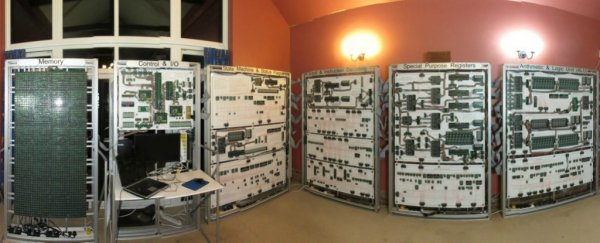James Newman, an electrical engineer from the UK, has spent the last four years and over US$53,000 creating a 10-metre (33-foot) wide 'megaprocessor' in his home that can play everyone's favourite classic, Tetris.
Despite the device's enormous size, it only performs about as well as a standard, chip-sized microprocessor (and not even a very good one at that).
"The machine on your desk may be a million times better than what I have built - but mine is much prettier," Newman told Zoe Kleinman from the BBC. "Mine has 10,000 times more LEDs."
Newman started working on the gigantic processor back in 2012 to visualise how microprocessors work, basically creating an educational tool so people can understand more about the hidden inner-workings of the technology they use every day.
"Computers are quite opaque, looking at them it's impossible to see how they work. What I would like to do is get inside and see what's going on," Newman explains on his site. "Trouble is we can't shrink down small enough to walk inside a silicon chip."
"But we can go the other way; we can build the thing big enough that we can walk inside it. Not only that we can also put LEDs on everything so we can actually SEE the data moving and the logic happening. It's going to be great," he says.
Now, after finally finishing the machine, it weighs in at roughly 500 kilograms (1,102 pounds), measures 10 metres (33 feet) wide and 2 metres (6 feet) tall, and contains over 40,000 transistors and 10,000 LEDs.
So far, Newman has only used the megaprocessor to run the video game Tetris, though it might also be able to play other old-school puzzle games.
The next step for Newman is to figure out what exactly he is going to do with the device. Right now, he says that he might open his house up to the public for them to get a chance to see it, but nothing has been verified yet.
"My dream is that it goes to a museum or educational institute so that people can learn from it," he told the BBC. "I doubt I'll be able to sell it."
While Newman's computer seems pretty ridiculous to us today, it wasn't all that long ago - on the grand scale of things, anyway - that every computer was the size of a room. One of the most noteworthy early computers was the Colossus - a machine built in the UK during World War II to crack encrypted messages that took up roughly the same amount of space as Newman's.
"Colossus was the first of the electronic digital machines with programmability, albeit limited in modern terms," explains the National Museum of Computing in the UK. "The notion of a computer as a general purpose machine - that is, as more than a calculator devoted to solving difficult but specific problems - would not become prominent for several years."
While the Colossus might have had a tougher task on its plate than playing Tetris, it makes you appreciate just how far our technology has progressed over the years.
You can watch Newman give a tour of his megaprocessor below!

